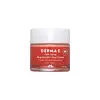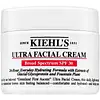What's inside
What's inside
 Key Ingredients
Key Ingredients

 Benefits
Benefits

 Concerns
Concerns

 Ingredients Side-by-side
Ingredients Side-by-side

Water
Skin ConditioningGlycerin
HumectantCaprylic/Capric Triglyceride
MaskingStearic Acid
CleansingCetyl Alcohol
EmollientGlyceryl Stearate Citrate
EmollientGlyceryl Stearate
EmollientPanthenol
Skin ConditioningDimethicone
EmollientSimmondsia Chinensis Seed Oil
EmollientTocopheryl Acetate
AntioxidantXanthan Gum
EmulsifyingCetearyl Glucoside
EmulsifyingAllantoin
Skin ConditioningPinus Pinaster Bark Extract
AntioxidantSodium Hydroxide
BufferingBakuchiol
AntimicrobialAstaxanthin
Skin ConditioningLavandula Angustifolia Oil
MaskingSalvia Officinalis Oil
MaskingLimonene
PerfumingPolysorbate 20
EmulsifyingRetinol
Skin ConditioningEucalyptol
PerfumingCopaifera Reticulata Balsam Oil
PerfumingMentha Viridis Leaf Oil
AstringentBeta-Caryophyllene
MaskingCamphor
MaskingCitral
PerfumingL-Alpha-Pinene
PerfumingGeranyl Acetate
PerfumingAnthemis Nobilis Flower Oil
MaskingL-Beta-Pinene
PerfumingMelaleuca Alternifolia Leaf Oil
AntioxidantIsobornyl Acetate
MaskingNeryl Acetate
PerfumingMenthone
PerfumingBenzyl Acetate
MaskingCitronellal
MaskingTerpineol
MaskingMenthyl Acetate
MaskingPhenoxyethanol
PreservativePotassium Sorbate
PreservativeEthylhexylglycerin
Skin ConditioningWater, Glycerin, Caprylic/Capric Triglyceride, Stearic Acid, Cetyl Alcohol, Glyceryl Stearate Citrate, Glyceryl Stearate, Panthenol, Dimethicone, Simmondsia Chinensis Seed Oil, Tocopheryl Acetate, Xanthan Gum, Cetearyl Glucoside, Allantoin, Pinus Pinaster Bark Extract, Sodium Hydroxide, Bakuchiol, Astaxanthin, Lavandula Angustifolia Oil, Salvia Officinalis Oil, Limonene, Polysorbate 20, Retinol, Eucalyptol, Copaifera Reticulata Balsam Oil, Mentha Viridis Leaf Oil, Beta-Caryophyllene, Camphor, Citral, L-Alpha-Pinene, Geranyl Acetate, Anthemis Nobilis Flower Oil, L-Beta-Pinene, Melaleuca Alternifolia Leaf Oil, Isobornyl Acetate, Neryl Acetate, Menthone, Benzyl Acetate, Citronellal, Terpineol, Menthyl Acetate, Phenoxyethanol, Potassium Sorbate, Ethylhexylglycerin
Water
Skin ConditioningGlycerin
HumectantOctocrylene
UV AbsorberHomosalate
Skin ConditioningEthylhexyl Salicylate
UV AbsorberSqualane
EmollientButyl Methoxydibenzoylmethane
UV AbsorberDimethicone
EmollientPEG-100 Stearate
Glyceryl Stearate
EmollientSilica
AbrasiveOctyldodecanol
EmollientStearic Acid
CleansingPhenoxyethanol
PreservativePalmitic Acid
EmollientTocopherol
AntioxidantDicaprylyl Carbonate
EmollientSteareth-100
Gel FormingAcrylates/C10-30 Alkyl Acrylate Crosspolymer
Emulsion StabilisingOphiopogon Japonicus Root Extract
Skin ConditioningCarbomer
Emulsion StabilisingChlorphenesin
AntimicrobialCapryloyl Salicylic Acid
ExfoliatingCaprylyl Glycol
EmollientXanthan Gum
EmulsifyingDimethicone/Vinyl Dimethicone Crosspolymer
Skin ConditioningDisodium EDTA
Sodium Hydroxide
BufferingCitrus Aurantium Dulcis Peel Oil
MaskingLimonene
PerfumingEctoin
Skin ConditioningHydrolyzed Hyaluronic Acid
HumectantMyristic Acid
CleansingMentha Piperita Oil
MaskingPseudoalteromonas Ferment Extract
HumectantEthylhexylglycerin
Skin ConditioningLinalool
PerfumingSalicylic Acid
MaskingWater, Glycerin, Octocrylene, Homosalate, Ethylhexyl Salicylate, Squalane, Butyl Methoxydibenzoylmethane, Dimethicone, PEG-100 Stearate, Glyceryl Stearate, Silica, Octyldodecanol, Stearic Acid, Phenoxyethanol, Palmitic Acid, Tocopherol, Dicaprylyl Carbonate, Steareth-100, Acrylates/C10-30 Alkyl Acrylate Crosspolymer, Ophiopogon Japonicus Root Extract, Carbomer, Chlorphenesin, Capryloyl Salicylic Acid, Caprylyl Glycol, Xanthan Gum, Dimethicone/Vinyl Dimethicone Crosspolymer, Disodium EDTA, Sodium Hydroxide, Citrus Aurantium Dulcis Peel Oil, Limonene, Ectoin, Hydrolyzed Hyaluronic Acid, Myristic Acid, Mentha Piperita Oil, Pseudoalteromonas Ferment Extract, Ethylhexylglycerin, Linalool, Salicylic Acid
Ingredients Explained
These ingredients are found in both products.
Ingredients higher up in an ingredient list are typically present in a larger amount.
Dimethicone is a type of synthetic silicone created from natural materials such as quartz.
What it does:
Dimethicone comes in different viscosities:
Depending on the viscosity, dimethicone has different properties.
Ingredients lists don't always show which type is used, so we recommend reaching out to the brand if you have questions about the viscosity.
This ingredient is unlikely to cause irritation because it does not get absorbed into skin. However, people with silicone allergies should be careful about using this ingredient.
Note: Dimethicone may contribute to pilling. This is because it is not oil or water soluble, so pilling may occur when layered with products. When mixed with heavy oils in a formula, the outcome is also quite greasy.
Learn more about DimethiconeEthylhexylglycerin (we can't pronounce this either) is commonly used as a preservative and skin softener. It is derived from glyceryl.
You might see Ethylhexylglycerin often paired with other preservatives such as phenoxyethanol. Ethylhexylglycerin has been found to increase the effectiveness of these other preservatives.
Glycerin is already naturally found in your skin. It helps moisturize and protect your skin.
A study from 2016 found glycerin to be more effective as a humectant than AHAs and hyaluronic acid.
As a humectant, it helps the skin stay hydrated by pulling moisture to your skin. The low molecular weight of glycerin allows it to pull moisture into the deeper layers of your skin.
Hydrated skin improves your skin barrier; Your skin barrier helps protect against irritants and bacteria.
Glycerin has also been found to have antimicrobial and antiviral properties. Due to these properties, glycerin is often used in wound and burn treatments.
In cosmetics, glycerin is usually derived from plants such as soybean or palm. However, it can also be sourced from animals, such as tallow or animal fat.
This ingredient is organic, colorless, odorless, and non-toxic.
Glycerin is the name for this ingredient in American English. British English uses Glycerol/Glycerine.
Learn more about GlycerinGlyceryl Stearate is a mix of glycerin and stearic acid.
It is used to stabilize the mixing of water and oil ingredients. By preventing these ingredients from separating, it can help elongate shelf life. It can also help thicken the product's texture.
As an emollient, it helps soften skin and supports barrier-replenishing ingredients.
In cosmetics, Glyceryl Stearate is often made from vegetable oils or synthetically produced.
This ingredient may not be fungal-acne safe
Fun fact: The human body also creates Glyceryl Stearate naturally.
Learn more about Glyceryl StearateLimonene is a fragrance that adds scent and taste to a formulation.
It's found in the peel oil of citrus fruits and other plants such as lavender and eucalyptus. The scent of limonene is generally described as "sweet citrus".
Limonene acts as an antioxidant, meaning it helps neutralize free radicals.
When exposed to air, oxidized limonene may sensitize the skin. Because of this, limonene is often avoided by people with sensitive skin.
The term 'fragrance' is not regulated in many countries. In many cases, it is up to the brand to define this term. For instance, many brands choose to label themselves as "fragrance-free" because they are not using synthetic fragrances. However, their products may still contain ingredients such as essential oils that are considered a fragrance.
Learn more about LimonenePhenoxyethanol is a preservative that has germicide, antimicrobial, and aromatic properties. Studies show that phenoxyethanol can prevent microbial growth. By itself, it has a scent that is similar to that of a rose.
It's often used in formulations along with Caprylyl Glycol to preserve the shelf life of products.
Sodium Hydroxide is also known as lye or caustic soda. It is used to adjust the pH of products; many ingredients require a specific pH to be effective.
In small amounts, sodium hydroxide is considered safe to use. However, large amounts may cause chemical burns due to its high alkaline.
Your skin has a natural pH and acid mantle. This acid mantle helps prevent harmful bacteria from breaking through. The acid mantle also helps keep your skin hydrated.
"Alkaline" refers to a high pH level. A low pH level would be considered acidic.
Learn more about Sodium HydroxideStearic Acid is a fatty acid. It is an emollient, emulsifier, and texture enhancer.
As an emollient, stearic acid helps soften skin. It aids the skin's protective barrier by preventing water loss. It also provides a gentle cleansing effect without stripping away natural oils.
Stearic acid may also be used to enhance the texture of products. It can add volume and stabilize ingredients such as water and oil. This can help water and oil ingredients from separating.
Sources of stearic acid include animal or vegetable fats/oils such as coconut or shea. It can be naturally found in butter, cocoa butter, shea butter, vegetable fats, and animal tallow.
This ingredient may not be Malassezia folliculitis, or fungal-acne safe.
Learn more about Stearic AcidWater. It's the most common cosmetic ingredient of all. You'll usually see it at the top of ingredient lists, meaning that it makes up the largest part of the product.
So why is it so popular? Water most often acts as a solvent - this means that it helps dissolve other ingredients into the formulation.
You'll also recognize water as that liquid we all need to stay alive. If you see this, drink a glass of water. Stay hydrated!
Learn more about WaterXanthan gum is used as a stabilizer and thickener within cosmetic products. It helps give products a sticky, thick feeling - preventing them from being too runny.
On the technical side of things, xanthan gum is a polysaccharide - a combination consisting of multiple sugar molecules bonded together.
Xanthan gum is a pretty common and great ingredient. It is a natural, non-toxic, non-irritating ingredient that is also commonly used in food products.
Learn more about Xanthan Gum